 W
WThe Macau Peninsula is the most populous and historic part of Macau. It has an area of 8.5 square kilometers (3.3 sq mi) and is geographically connected to Guangdong province at the northeast through an isthmus 200 meters (660 ft) wide. The peninsula, together with downtown Zhuhai, sits on an island separated from the continent by distributaries of the Pearl River. The Border Gate was built on the northern isthmus. At the south, the peninsula is connected to Taipa Island by three bridges, the Friendship Bridge ; the Macau-Taipa Bridge ; and the Sai Van Bridge . The longest axis extends 4 kilometers (2.5 mi) from the Border Gate to the southwestern edge, Barra (媽閣嘴). There is a western "Inner Harbor" (內港) paralleled by an "Outer Harbor" (外港) to the east. The 93 meters (305 ft) Guia Hill (松山) is the highest point on the peninsula, which has an average elevation of 50 to 75 meters. Many coastal places are reclaimed from the sea. The Historic Center of Macau, which is entirely on the Macau Peninsula, became a World Heritage Site in 2005.
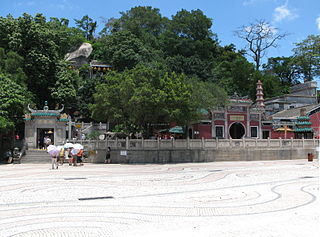 W
WThe A-Ma Temple is a temple to the Chinese sea-goddess Mazu located in São Lourenço, Macau, China. Built in 1488, the temple is one of the oldest in Macau and thought to be the settlement's namesake.
 W
WThe Archives of Macao is a general archive in São Lázaro, Macau. It collects, processes, protects and make available records pertaining Macau.
 W
WAvenida de Almeida Ribeiro, also commonly known as San Ma Lo, is the main avenue in the heart of Macau Peninsula. The 620 metres long avenue was laid out in 1920 and it extends from the Inner to the Outer harbour, passing through the old residential area with its rows of colourful street shops.
 W
WThe Macau Canidrome Club, located in Nossa Senhora de Fátima, Macau, China, was the only greyhound racing stadium in Asia. Around 120 dogs took part in 16 races five days per week. It had two grandstands, several private boxes and a VIP lounge. It shares the venue with Lin Fong Sports Centre, a sport complex.
 W
WCasino Lisboa is a hotel casino in Sé, Macau, China. The casino is owned by the Sociedade de Turismo e Diversões de Macau (STDM), a Stanley Ho company. This three-storey complex was built in late 1960s.
 W
WThe Communications Museum is a museum in Nossa Senhora de Fátima, Macau, China.
 W
WThe Dom Pedro V Theatre, is a historical theatre situated at Largo de Santo Agostinho in São Lourenço, Macau, China. It is one of the first western-style theatres in East Asia. The theater is an important landmark in the region and remains a venue for important public events and celebrations today.
 W
WFai Chi Kei is a place located in Nossa Senhora de Fátima, Macau. It was originally a sandbank near the peninsula. The area is bounded by Rua da Bacia Sul, Avenida Marginal do Lam Mau, Rua da Doca Seca and Rua Sul do Patane.
 W
WThe Fire Services Museum is a museum about firefighting in Santo António, Macau, China.
 W
WMong-Há Fort is a fort on Mong-Há Hill, Nossa Senhora de Fátima, Macau, China. The fort is part of a greater military reservation - the Bairro Militar de Mong-Há, which included the Quartel de Mong-Há. The Bairro Militar is bound by the Rua Francisco Xavier Pereira and the Colina de Mong-Há. The main fort complex was erected 1849 by Governor Ferreira do Amaral to protect the Macau's northern sector as precaution against a possible Chinese invasion following the First Opium War between Britain and China (1839-1842).
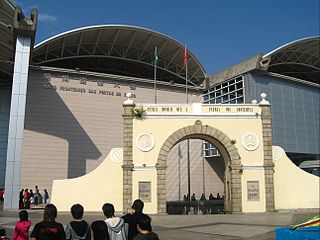 W
WNossa Senhora de Fátima is the northernmost and largest civil parish in the Macau Peninsula of Macau. It has an area of 2.7 square kilometers (1.0 sq mi) and a population of 126,000, which constitutes about 40.3% of the peninsula's land mass and one-third of the population.
 W
WSanto António is a civil parish in the western portion of the Macau Peninsula of Macau. It has the highest population density in Macau.
 W
WSão Lázaro is the smallest civil parish of Macau, located in the central-east region of the Macau Peninsula. It is surrounded by the parishes of Nossa Senhora de Fátima, Santo António, and Sé.
 W
WSão Lourenço is a civil parish of Macau. It is located in the southwestern of Macau Peninsula and named after Lawrence of Rome.
 W
WIlha Verde, also known by its Cantonese name Cing-zau and Mandarin name Qingzhou, is an area in the northwest of Macau Peninsula, Macau that forms part of the Our Lady Fatima Parish. It is a former island—known in English as Verde or Green Island—to the west of the Macau Isthmus. It was settled by Jesuits.
 W
WKeang Peng School is a private school in Nossa Senhora de Fátima, Macau, with two campuses, one each for preschool/primary and secondary levels.
 W
WKwong Tai Middle School or Guang Da Middle School is a private school in Macau, serving preschool through secondary school. It has a main campus in Nossa Senhora de Fátima and a branch campus in Santo António.
 W
WThe Leal Senado Building was the seat of Portuguese Macau's government. It is located at one end of the Senado Square in São Lourenço, Macau, China. The title was bestowed on Macau's government in 1810 by Portugal's Prince Regent João, who later became King John VI of Portugal. This was a reward for Macau's loyalty to Portugal, which refused to recognise Spain’s sovereignty during the Philippine Dynasty that it occupied Portugal, between 1580 and 1640. A plaque ordered by the king commemorating this can still be seen inside the entrance hall.
 W
WThere is currently one island in the territory of Macau. It is located at the south of Macau Peninsula and at the east of the Hengqin Island of Zhujiang, Guangdong Province, China. The island remains unnamed since its creation in the late 1990s, after the reclamation project of Cotai which filled up the channel between the Taipa Island and Coloane Island.
 W
WThe Macau Military Club is a club and restaurant in Sé, Macau, China.
 W
WMorrison Chapel, also known as Morrison Protestant Chapel, is an Anglican chapel situated in Camões Square, Santo António, Macau. Originally built in the early 19th century to serve the spiritual needs of the employees of East India Company, the chapel now serves the worshipers with a variety of denominational backgrounds in the Missionary Area of Macau. The present Chapel was built in 1922.
 W
WThe Macao Tea Culture House is a museum about tea in São Lázaro, Macau, China.
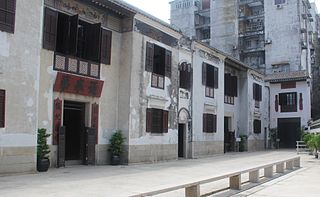 W
WMandarin's House is a historic residential complex in São Lourenço, Macau. It was the residence and family home of the late Qing theoretician and reformist Zheng Guanying (1842-1921). He completed his masterpiece of Shengshi Weiyan in the house. Mandarin's House occupies an area of 4,000 square metres (43,000 sq ft), which is amongst the largest family houses in Macau.
 W
WMGM Macau is a 35-story, 600-room casino resort in Sé, Macau. Under a sub concession approved by the Macau government, the project is owned and operated as a 50–50 joint venture between MGM Resorts International and Pansy Ho, daughter of Macau casino magnate Stanley Ho. The sub-concession is one of several examples of new casino construction following the end of the government-granted monopoly held for decades by Stanley Ho.
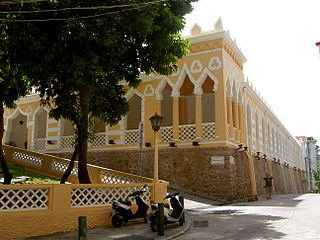 W
WThe Moorish Barracks is a historical barracks in São Lourenço, Macau, China.
 W
WThe Museum of Sacred Art and Crypt is a museum in Santo António, Macau, China.
 W
WThe Na Tcha Temple, built in 1888, is a Chinese folk religion temple in Santo António, Macau, China. It is dedicated to the worship of the popular Deity Na Tcha (哪吒) or Sam Tai Tsz (三太子).
 W
WThe Old Protestant Cemetery is a cemetery in Santo António, Macau, China. It was established by the British East India Company in 1821 in Portuguese Macau in response to a lack of burial sites for Protestants in the Roman Catholic Portuguese colony.
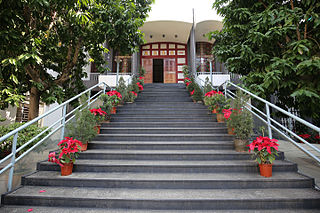 W
WThe Our Lady of Fátima Church Macau is a church in Nossa Senhora de Fátima, Macau, China.
 W
WThe Our Lady of Penha Chapel is a church in São Lourenço, Macau, China.
 W
WThe Penha Hill is a hill in São Lourenço, Macau, China.
 W
WThe Portas do Cerco is an area in Nossa Senhora de Fátima, Macau, China. Located on the northern tip of the Macau Peninsula, it is known by the Barrier Gate separating Macau from mainland China. The Portuguese built the gate in 1849 to replace a crumbling wall that the Chinese erected during the Ming dynasty in 1573. The Chinese built a garrisoned wall to control the flow of people and goods. It was the site of the Passaleão incident, a clash between the Qing dynasty and the Kingdom of Portugal in 1849 over the death of Macau's governor Ferreira do Amaral. Led by Colonel Mesquita, Portugal won the small battle which led to the extension of Macau's border northwards. At the limit of said expansion, the Portas do Cerco was built with the inscription "A pátria honrai, que a pátria vos contempla" on the façade on its inner arch in 1849. The Barrier Gate served as a de facto boundary, but the precise limits of Macau's border has never been formally demarcated.
 W
WThe Red Market, officially Almirante Lacerda Market is a three-story wet market building in Santo António, Macau, China.
 W
WThe Ruins of Saint Paul's are the ruins of a 17th-century Catholic religious complex in Santo António, Macau, China. They include what was originally St. Paul's College and the Church of St. Paul also known as "Mater Dei", a 17th-century Portuguese church dedicated to Saint Paul the Apostle. Today, the ruins are one of Macau's best known landmarks and one of the Seven Wonders of Portuguese Origin in the World. In 2005, they were officially listed as part of the Historic Centre of Macau, a UNESCO World Heritage Site.
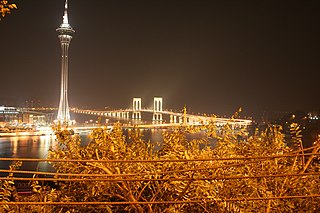 W
WSé is a southeast civil parish in the Macau Peninsula of Macau. It is the second largest peninsular district in Macau after the civil parish of Nossa Senhora de Fátima. The parish area is named for the Igreja da Sé.
 W
WThe Sofitel Macau At Ponte 16 is a hotel in Santo António, Macau, China. It is part of Sofitel Luxury Hotels, an up-market hotel brand which forms part of one of the world's leading hotel chains, Accor Hospitality, based in France. Over the past few years since opening its doors in 2008, Sofitel Macau and the management have been credited a number of tourism awards.
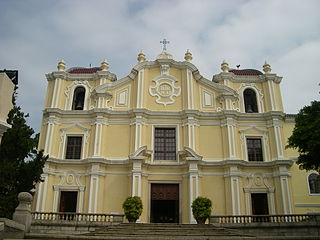 W
WThe St. Joseph's Seminary and Church is a seminary and church located in São Lourenço, Macau, China.
 W
WSun Yat Sen Memorial House or Memorial House of Dr. Sun Yat Sen is a museum located in São Lázaro, Macau, China where former family members and relatives of Sun Yat-sen, the 'Father of Modern China' used to live. The House bears witness to his short but significant stay in Macau in the early 20th century where Macau serve as the starting point for Dr. Sun's travels around the world; it also act as an important venue in which he conducted revolutionary activities and finally as the ideal place he chose to settle his family in later years.
 W
WThe Tai Fung Tong Art House is an exhibition venue in São Lázaro, Macau, China.
 W
WThe Inner Harbour Ferry Terminal is a passenger pier in São Lourenço, Macau, China. The ferry terminal is dedicated for ferries to the nearby Wanzai, Zhuhai.
 W
WThe World Trade Center Macau is a trade and convention facility in Macau, China. The 19-story tower and complex was built by Portuguese architect Manuel Vicente and completed in 1996, three years before the handover from the Portuguese back to China.